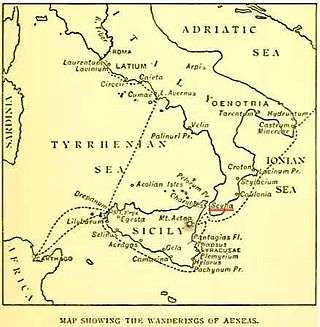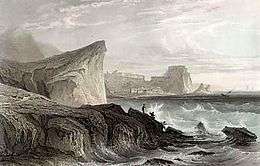Charybdis
Charybdis (/kəˈrɪbdɪs/; Ancient Greek: Χάρυβδις, pronounced [kʰárybdis], Kharubdis) is a sea monster in Greek mythology. Subsequent scholarship has suggested that it was based on a whirlpool in the Strait of Messina.
Description

The sea monster Charybdis was believed to live under a small rock on one side of a narrow channel. Opposite her was Scylla, another sea monster, that lived inside a much larger rock.[1] The sides of the strait were within an arrow-shot of each other, and sailors attempting to avoid one of them would come in reach of the other. To be "between Scylla and Charybdis" therefore means to be presented with two opposite dangers, the task being to find a route that avoids both. Three times a day, Charybdis swallowed a huge amount of water, before belching it back out again, creating large whirlpools capable of dragging a ship underwater. In some variations of the story, Charybdis was simply a large whirlpool instead of a sea monster.
The theoretical size of Charybdis remains unknown, yet in order to consume Greek ships the whirlpool can be estimated to about 23 meters (75 ft) across. Through the descriptions of Greek mythical chroniclers and Greek historians such as Thucydides, modern scholars generally agree that Charybdis was said to have been located in the Strait of Messina, off the coast of Sicily and opposite a rock on the mainland identified with Scylla.[2] Were Charybdis to be located in the Strait of Messina, it would in fact have the size to accommodate the whirlpool. A whirlpool does exist there, caused by currents meeting, but it is dangerous only to small craft in extreme conditions.[3]
Genealogy
A later myth makes Charybdis the daughter of Poseidon and Gaia[4] and living as a loyal servant to her father.
Mythology
Origin
Charybdis aided her father Poseidon in his feud with her paternal uncle Zeus and, as such, helped him engulf lands and islands in water. Zeus, angry over the land she stole from him, captured and chained her to the sea-bed. Charybdis was then cursed by the god and transformed into a hideous bladder of a monster, with flippers for arms and legs, and an uncontrollable thirst for the sea. As such, she drank the water from the sea thrice a day to quench it, which created whirlpools.[5][6] She lingered on a rock with Scylla facing her directly on another rock, making a strait.
The Odyssey

Odysseus faced both Charybdis and Scylla while rowing through a narrow channel. He ordered his men to avoid Charybdis, thus forcing them to pass near Scylla, which resulted in the deaths of six of his men. Later, stranded on a raft, Odysseus was swept back through the strait and passed near Charybdis. His raft was sucked into her maw, but he survived by clinging to a fig tree growing on a rock over her lair. On the next outflow of water, when his raft was expelled, Odysseus recovered it and paddled away safely.[7]
Jason and the Argonauts
The Argonauts were able to avoid both dangers because Hera ordered the Nereid nymph Thetis, Achilles' mother, to guide them through the perilous passage.[8]
The Aeneid
In the Aeneid the Trojans are warned by Helenus of Scylla and Charybdis, and are advised to avoid them by sailing around Pachynus point (Cape Passero) rather than risk the Straits[9] . Later however they find themselves passing Etna, and have to row for their lives to escape Charybdis.[10]
Aesop
Aristotle mentions in his Meteorologica that Aesop once teased a ferryman by telling him a myth concerning Charybdis. With one gulp of the sea, she brought the mountains to view; islands appeared after the next. The third is yet to come and will dry the sea altogether, thus depriving the ferryman of his livelihood.[11]
Notes
| Wikimedia Commons has media related to Charybdis. |
- Odyssey. pp. Book XII.
- Thucydides. History of the Peloponnesian War 4.24.5.
- Andrews, Tamra (2000). Dictionary of Nature Myths: Legends of the Earth, Sea, and Sky. Oxford University Press. p. 171. ISBN 978-0-19-513677-7. Retrieved 25 May 2016.
- Scholiast on Homer's Odyssey
- "Charybdis". www.greekmythology.com. Retrieved 5 October 2016.
- "Charybdis (Kharybdis) – Whirlpool Monster of Greek Mythology". www.theoi.com. Retrieved 5 October 2016.
- Homer, Odyssey Book 12, lines 201–59 and 430–50
- Apollonius Rhodius , Argonautica Book 4, lines 821–960
- Gutenberg Project: The Aeneid E. F. Taylor translation (1907) Bk 3, 487-504
- Gutenberg Project: The Aeneid E. F. Taylor translation (1907) Bk 3, 636-648
- Gert-Jan van Dijk, Ainoi, logoi, mythoi: fables in archaic, classical, and Hellenistic Greek literature, Brill NL 1997,; pp. 351–53
References
External links
- Chisholm, Hugh, ed. (1911). . Encyclopædia Britannica. 24 (11th ed.). Cambridge University Press. p. 519.